
A STOMPer was passing by some palm trees at Tanglin Halt Road when he spotted these civet cat stuffed animals on the stem of one of the trees.
In an email to STOMP today (Mar 23), the STOMPer says:
"These pictures were taken near Blk 48 at Tanglin Halt Road.
"As I was passing by some palm trees, I noticed two civet cats eyeing each other on the stem of the tree.
"As I gazed longer I noticed that they were not moving at all. Perhaps someone put these two cats on the tree to beautify the place.
"Say what you like, these two civet cats look quite realistic and they add colour to this dull hawker centre."
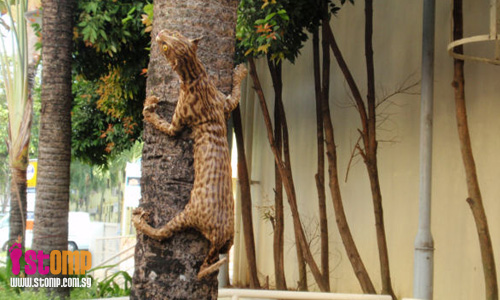
Repeat after me: Civets are NOT cats.
Although civets are also often known as civet cats, they form the Viverridae, which is a completely separate family from the cats, which make up the Felidae.

Here's a recent schematic cladogram from a 2005 paper, which shows you the phylogenetic relationships between the various extant carnivores. So while civets and cats are close relatives, they still form separate families.
Anyway, the taxidermied creatures (I dislike using the word 'stuffed' because it makes me think of cute and soft plush toys) appear to be leopard cat (Prionailurus bengalensis), which is also Singapore's last surviving wild cat. Critically endangered, its remaining strongholds in mainland Singapore appear to be the forests within and around the Central Nature Reserves and Western Catchment Area; in fact, the only physical evidence we have that leopard cats still exist in these areas is the presence of 2 roadkill specimens: the first was found along Mandai Road in 2001, while the second was found on Jalan Bahar in 2007. The Mandai Road leopard cat now resides in the public gallery of the Raffles Museum of Biodiversity Research (RMBR).
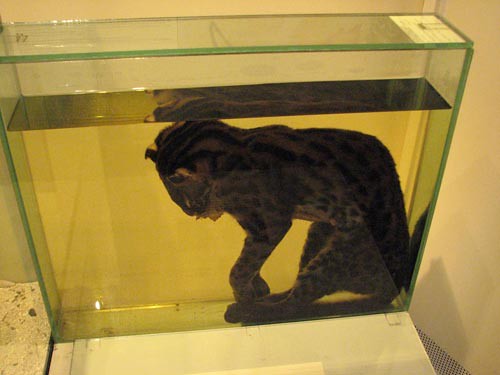
Leopard cat, RMBR gallery;
(Photo by access_2359)
Pulau Ubin and Pulau Tekong are also known to have their own leopard cat populations. However, the best place to see leopard cats is at the Singapore Zoo and Night Safari.

Leopard cat, Singapore Zoo;
(Photo by dbillian)
The leopard cat is widespread throughout much of tropical and temperate Asia, from Pakistan and India in the west, north to China, Manchuria and the Korean Peninsula, and all the way to Sumatra, Borneo, Java and some islands of the Philippines. In fact, it probably has the widest distribution of any Asian cat. About the size of your average domestic cat (Felis silvestris catus), the leopard cat feeds on prey such as small birds and mammals, frogs, lizards and even insects. This species is quite adaptable, and can live in logged forests, and can even survive in agricultural land and plantations. In rural areas, they can become raiders of poultry.
The specimens in the original post appear to have undergone some sort of horrendous transformation that leaves them horribly mangled and mutilated, and hardly recognisable as leopard cats. Unfortunately, one is sometimes able to find leopard cats, both dead or alive, being sold in markets in the region. Apparently, there is also a disturbing practice of locals showcasing their lack of skill in taxidermy. What surprises (and disgusts) me is that these stuffed examples of local wildlife are often sold as souvenirs to tourists.

Stuffed leopard cat seen in souvenir shop, Phnom Penh;
(Photo by Arddu)
Absolutely hideous, isn't it? I wonder if taxidermists all over Indochina have agreed to give their leopard cat specimens that googly-eyed, perpetually-high-on-drugs look.
Whether it's for traditional medicine, fur, tacky souvenirs, or the exotic pet trade, there is no doubt that hunting and habitat loss are threatening all of the cat species found in tropical Asia, including the leopard cat.
I'm not sure how the stuffed leopard cats in the original post ended up being mounted onto a tree. Were they captured and prepared locally decades ago, during a time when leopard cats were more common? Or are they more recent, having been purchased in a market in Cambodia or Vietnam before being smuggled in? Does this count as illegally importing and possessing an endangered species? According to the Endangered Species (Import and Export) Act:
4.—(1) Any person who imports, exports, re-exports or introduces from the sea any scheduled species without a permit shall be guilty of an offence and shall be liable on conviction to a fine not exceeding $50,000 for each such scheduled species (but not to exceed in the aggregate $500,000) or to imprisonment for a term not exceeding 2 years or to both.
(2) Any person who has in his possession or under his control, or who sells, offers or exposes or advertises for sale, or displays to the public any scheduled species which has been imported or introduced from the sea in contravention of subsection (1) shall be guilty of an offence and shall be liable on conviction to a fine not exceeding $50,000 for each such scheduled species (but not to exceed in the aggregate $500,000) or to imprisonment for a term not exceeding 2 years or to both.
The leopard cat is a scheduled species, and is listed under Appendix II of the Convention on International Trade in Endangered Species (CITES), which means that international trade in leopard cats usually requires at least an export permit. The leopard cat populations found in India, Bangladesh and Thailand are listed under Appendix I, so all trade in leopard cats from these countries is prohibited unless accompanied by the necessary export and import permits.
In other words, if these leopard cat specimens don't have the required permits, the owner could get into quite a bit of trouble indeed.
Besides, I wonder how long they will survive in such an exposed place. Most stuffed animals will start to decompose sooner or later, and I wonder how these dead cats will smell.
While the leopard cat is Singapore's last surviving wild cat species, in the past, this country was inhabited by 4 other species of cat.
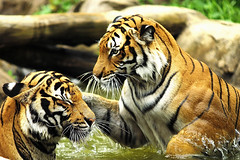
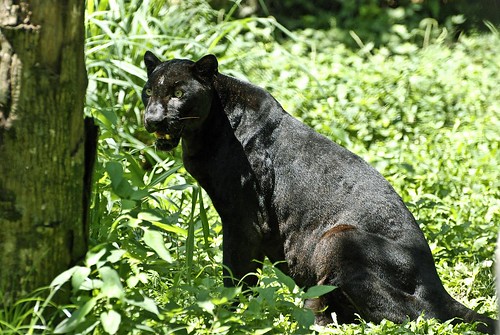
Left Tiger (Panthera tigris), Zoo Melaka;
(Photo by Polini Fotografik)
Right Leopard (Panthera pardus), Zoo Negara;
(Photos by kamaruld)
The tiger and leopard are long extinct. Habitat destruction, depletion of prey, and persecution for safety reasons meant that both big cat species were wiped out long before 1950.


Left Clouded leopard at (Neofelis nebulosa), Santago Rare Leopard Project, Hertfordshire;
(Photo by Steelsky Rust)
Right Flat-headed cat (Prionailurus planiceps), Zoo Taiping;
(Photo by Wakx)
Similarly, the clouded leopard and flat-headed cat have also vanished from Singapore.
Leopard cats are sometimes kept as exotic pets, although they never become as tame as domestic cats.
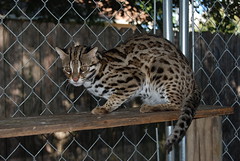
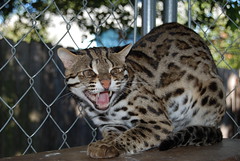
Leopard cat at Unique Prints Cattery, Texas;
(Photos by fancidots)
Just for the heck of it, here's a photo of a cute little leopard cat kitten:
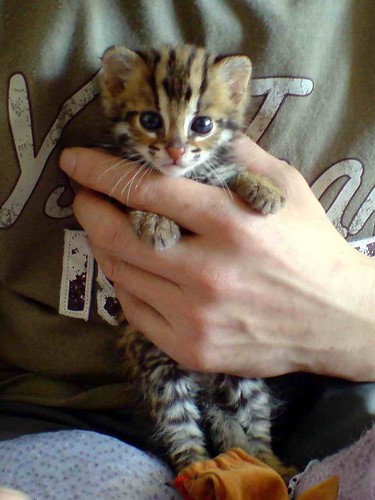
(Photo by euptilura)
Most cat breeders who keep leopard cats don't breed them for sale; instead, these leopard cats are mated with domestic cats. The resultant hybrid kittens, after being crossed with domestic cats for 3 generations, form the foundation of a new breed of domestic cat known as the Bengal, which combines the exotic appearance of the leopard cat with the temperament of a domestic cat.
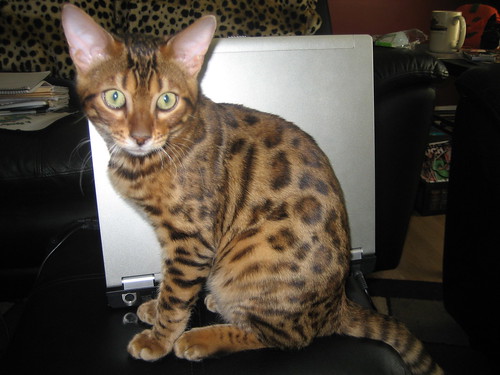
Bengal cat;
(Photo by marylandbengalcats.com)
Currently, 3 other species of wild cat are being crossed with domestic cats to produce new exotic breeds. These are the jungle cat (Felis chaus), Geoffrey's cat (Leopardus geoffroyi) and serval (Leptailurus serval). These are the breeds produced by crossing these species with domestic cats:
Chausie (Jungle cat X Domestic cat)
Savannah (Serval X Domestic cat)
Safari (Geoffrey's cat X Domestic cat)
The person who submitted the original post confused the leopard cats for civets. Civets are a family of 33 or so species, and are quite diverse in terms of their appearance and lifestyle; some, like the small-spotted genet (Genetta genetta), are a lot like slender cats with fox-like faces. Others, like the African civet (Civettictis civetta), are terrestrial and predominantly carnivorous. The palm civets are arboreal omnivores that consume a lot of fruit; the most distinctive palm civet species is the binturong (Arctictis binturong), with its long shaggy fur and prehensile tail.
While Singapore used to have 8 species of civet, only the common palm civet (Paradoxurus hermaphroditus) is now encountered with some regularity.
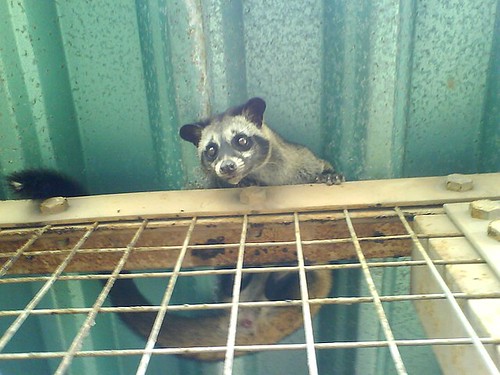
Common palm civet, Pasir Panjang;
(Photo by kampang)
This nocturnal arboreal omnivore can be found even in suburban areas. Although I have never encountered the common palm civet in Singapore, I have occasionally come upon little piles of its droppings on the Chek Jawa Boardwalk.
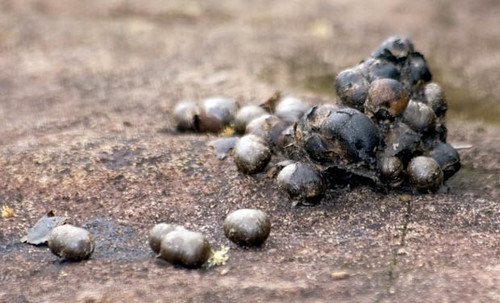
Common palm civet droppings, Pulau Ubin;
(Photo by Marcus)
Of course, it's impossible not to talk about kopi luwak when the subject of palm civet droppings is brought up.
As for the rest of the civet species once found in Singapore, the binturong, small-toothed palm civet (Arctogalidia trivirgata), masked palm civet (Paguma larvata), otter civet (Cynogale bennettii), Malay civet (Viverra tangalunga), large-spotted civet (Viverra megaspila), and large Indian civet (Viverra zibetha) are all either extinct or nearly so.
So to end this post, civets should definitely never ever be confused with cats. The culling of stray cats in the wake of SARS is one tragic example of what happens when people start thinking that civets are cats. Civets aren't cats, dammit.
Say, I wonder if it's legal to own those stuffed leopard cats in the first place...